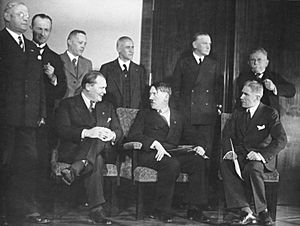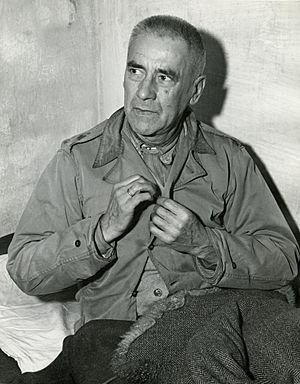Wilhelm Frick facts for kids
Quick facts for kids
Wilhelm Frick
|
|
|---|---|
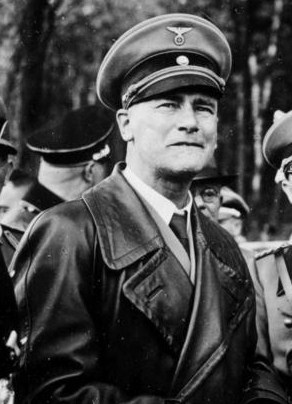
Frick in 1938
|
|
| Reichsminister of the Interior | |
| In office 30 January 1933 – 20 August 1943 |
|
| President | Paul von Hindenburg (1933–1934) Adolf Hitler (1934–1943; as Führer) |
| Chancellor | Adolf Hitler |
| Preceded by | Franz Bracht |
| Succeeded by | Heinrich Himmler |
| Protector of Bohemia and Moravia | |
| In office 24 August 1943 – 8 May 1945 |
|
| Appointed by | Adolf Hitler |
| Preceded by | Konstantin von Neurath (de jure) Kurt Daluege (de facto) |
| Succeeded by | Position abolished |
| Reichsleiter | |
| In office 10 October 1933 – 8 May 1945 |
|
| Appointed by | Adolf Hitler |
| Preceded by | None |
| Succeeded by | Position abolished |
| Reichsminister without Portfolio | |
| In office 24 August 1943 – 30 April 1945 |
|
| Member of the Reichstag (Nazi Germany) |
|
| In office 1933–1945 |
|
| (Weimar Republic) | |
| In office 1924–1933 |
|
| Personal details | |
| Born | 12 March 1877 Alsenz, Kingdom of Bavaria, German Empire |
| Died | 16 October 1946 (aged 69) Nuremberg Prison, Nuremberg, Bavaria, Allied-occupied Germany |
| Cause of death | Execution by hanging |
| Political party | Nazi Party |
| Spouses |
|
| Children | 5 |
| Alma mater | |
| Occupation | Attorney |
| Criminal conviction | |
| Criminal status | Executed |
| Conviction(s) | Crimes of aggression War crimes Crimes against humanity |
| Trial | Nuremberg trials |
| Criminal penalty | Death |
Wilhelm Frick (born March 12, 1877 – died October 16, 1946) was an important German politician. He was a member of the Nazi Party (NSDAP). From 1933 to 1943, he served as the Minister of the Interior in Adolf Hitler's government. He also became the last governor of the Protectorate of Bohemia and Moravia.
Frick was involved in Hitler's attempt to take power in 1923, known as the Beer Hall Putsch. After this, he became a key figure in the Nazi Party in the German parliament, the Reichstag. When Hitler became Chancellor in 1933, Frick joined the new government. He helped create many laws that strengthened the Nazi regime. These laws also included rules about who was considered German, like the famous Nuremberg Laws.
Before World War II started in 1939, Frick was part of a special war cabinet. Over time, his power within the party lessened. In 1943, Heinrich Himmler took over his role as Interior Minister. Frick remained in the government as a minister without a specific department until Hitler's death in 1945.
After World War II, Frick was put on trial for his actions during the war. He was found responsible for certain events and faced consequences for his role.
Contents
Early Life and Education
Wilhelm Frick was born in Alsenz, a town in Germany, on March 12, 1877. He was the youngest of four children. His father, Wilhelm Frick Sr., was a teacher.
Frick went to school in Kaiserslautern and finished his exams in 1896. He first studied languages at the University of Munich. However, he soon changed his focus to law. He studied law at Heidelberg and Humboldt University of Berlin.
In 1903, Frick started working for the Bavarian government. He became an attorney at the Munich Police Department. He continued to work in different government roles. He was not able to serve in World War I because he was deemed unfit. In 1917, he returned to the Munich Police Department.
Joining the Nazi Party
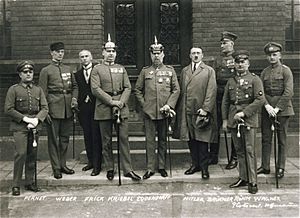
While working in Munich, Frick saw the end of World War I and the German Revolution of 1918–1919. He supported right-wing groups called Freikorps. The police chief, Ernst Pöhner, introduced Frick to Adolf Hitler. Frick helped Hitler get permission for political meetings and protests.
In 1923, Frick was the head of the political department of the Munich police. He and Pöhner took part in Hitler's failed attempt to take power on November 9, known as the Beer Hall Putsch. Frick tried to stop the police from interfering. Because of this, he was arrested and put on trial in April 1924. He received a suspended sentence and lost his police job. Later, his dismissal was reversed. From 1926, Frick worked at the Munich social insurance office.
After the putsch, Wilhelm Frick was elected to the German parliament, the Reichstag, in May 1924. He was part of a group linked to the Nazi Party, which was banned at the time. On September 1, 1925, Frick officially joined the re-established Nazi Party.
By May 20, 1928, he was one of the first 12 Nazi Party members elected to the Reichstag. He became known for his strong speeches against democracy and Jewish people. He rose to become the leader of the Nazi parliamentary group in 1928. He continued to be elected to the Reichstag in all future elections.
In 1929, the Nazi Party joined the government of the state of Thuringia. Frick was appointed as the Minister of the Interior and Education on January 23, 1930. This made him the first Nazi to hold a ministerial position in Germany. Frick used his power to remove officials who were not Nazis and replaced them with Nazi Party members. He also appointed Hans F. K. Günther, a supporter of eugenics, as a professor. Frick banned certain newspapers and anti-war films. He was removed from office in April 1931.
Minister in Hitler's Government
When Paul von Hindenburg appointed Hitler as Chancellor on January 30, 1933, Frick became the Reichsminister of the Interior. He was one of only two Nazi ministers in Hitler's first cabinet. Frick held a very important position, especially in organizing the elections in March 1933.
Frick's power grew significantly after the Reichstag Fire Decree and the Enabling Act of 1933. He helped create many of the laws that helped the Nazi regime take full control. For example, he helped draft a law that allowed the government to take over state governments. Under a law from January 30, 1934, Germany became a very centralized state. State parliaments were dissolved, and new governors, who reported directly to Frick, were put in charge.
Frick also became a member of the Academy for German Law. On October 10, 1933, Hitler made him a Reichsleiter, which was the second-highest political rank in the Nazi Party. In May 1934, he became the Prussian Minister of the Interior. This gave him control over the police in Prussia. By 1935, he had almost complete control over local governments. He could appoint the mayors of large cities.
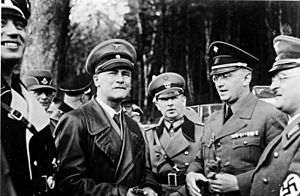
Frick played a key role in creating laws that targeted Jewish citizens. These included the "Law for the Restoration of the Professional Civil Service" and the well-known Nuremberg Laws in September 1935. In July 1933, he also put in place a law about preventing hereditary diseases. Frick was involved in Germany's re-arming, which went against the Treaty of Versailles. He drafted laws that brought back military service.
In the summer of 1938, Frick was the main supporter of a large sports festival in Breslau. Hitler and other Nazi leaders attended this event. Frick led a ceremony where a new standard was given to the Nazi Reich Sports League. This showed how sports in Germany were becoming more controlled by the Nazis. On November 11, 1938, Frick announced rules against Jewish people owning weapons.
From the mid-1930s, Frick started to lose influence within the Nazi Party. His power was greatly reduced in June 1936 when Hitler made Heinrich Himmler the Chief of German Police. This effectively combined the police with the SS. Although Frick was Himmler's superior on paper, the police were now independent of Frick's control. This was because the SS reported only to Hitler.
After a long struggle for power, Himmler replaced Frick as Reichsminister of the Interior in August 1943. However, Frick remained in the government as a minister without a specific department. He and Lutz Graf Schwerin von Krosigk were the only members of Hitler's cabinet who served continuously from Hitler becoming Chancellor until his death.
After being replaced as Interior Minister, Frick was appointed as the Protector of Bohemia and Moravia. This made him Hitler's personal representative in the Czech lands. The capital, Prague, was one of the last cities held by the Axis powers to fall at the end of World War II.
After World War II
After World War II, Frick was arrested. He was put on trial at the Nuremberg trials. He was found responsible for planning and waging wars of aggression, and for his role in creating laws that led to people being sent to concentration camps. He was also accused of being one of the most senior people responsible for the existence of the concentration camps.
Frick was sentenced to death on October 1, 1946. He was executed at Nuremberg Prison on October 16.
See also
 In Spanish: Wilhelm Frick para niños
In Spanish: Wilhelm Frick para niños
- Glossary of Nazi Germany
- List of Nazi Party leaders and officials


